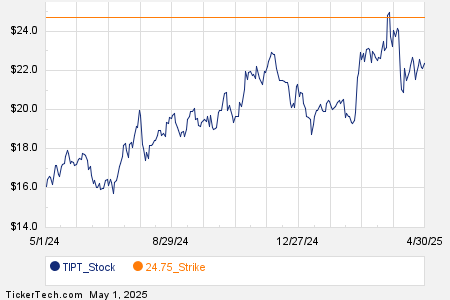Options Trading Highlights in Russell 3000: LKQ, Albemarle, and Qualcomm
Today, significant options trading activity was observed among several companies in the Russell 3000 index. LKQ Corp (Symbol: LKQ) reported a total of 14,158 contracts traded, equating to approximately 1.4 million underlying shares. This represents about 50.4% of LKQ’s average daily trading volume of 2.8 million shares over the past month. The $40 strike call option expiring on August 15, 2025, stood out with 6,002 contracts traded, reflecting about 600,200 underlying shares. Below is a chart illustrating LKQ’s trailing twelve-month trading history, with the $40 strike highlighted in orange:

Albemarle Corp. Options Trading Volume
Albemarle Corp. (Symbol: ALB) also experienced notable options trading, with volume reaching 20,636 contracts. This translates to about 2.1 million underlying shares, or roughly 50.2% of ALB’s average daily trading volume of 4.1 million shares over the past month. A particularly active segment included the $85 strike call option expiring on June 20, 2025, with 3,503 contracts traded today, representing approximately 350,300 underlying shares. Below is a chart showing ALB’s trailing twelve-month trading history, with the $85 strike highlighted in orange:

Qualcomm Inc. Options Activity
Qualcomm Inc. (Symbol: QCOM) recorded an impressive options trading volume of 52,413 contracts, or about 5.2 million underlying shares. This accounts for approximately 50.1% of QCOM’s average daily trading volume of 10.5 million shares over the previous month. The $110 strike put option expiring on May 02, 2025, attracted particular attention, with 2,901 contracts traded, representing roughly 290,100 underlying shares. Below is the chart illustrating QCOM’s trailing twelve-month trading history, with the $110 strike highlighted in orange:

For more information on available expirations for options related to LKQ, ALB, or QCOM, visit StockOptionsChannel.com.
![]() Today’s Most Active Call & Put Options of the S&P 500 »
Today’s Most Active Call & Put Options of the S&P 500 »
The views and opinions expressed herein are those of the author and do not necessarily reflect those of Nasdaq, Inc.

